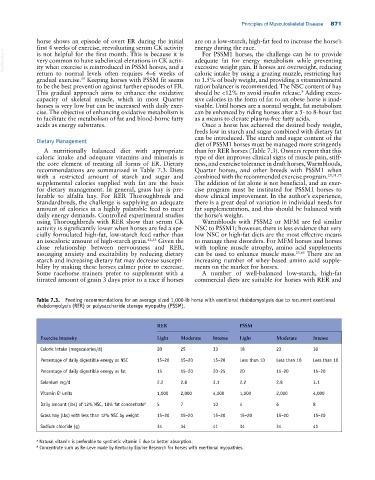Page 905 - Adams and Stashak's Lameness in Horses, 7th Edition
P. 905
Principles of Musculoskeletal Disease 871
horse shows an episode of overt ER during the initial are on a low‐starch, high‐fat feed to increase the horse’s
first 4 weeks of exercise, reevaluating serum CK activity energy during the race.
VetBooks.ir very common to have subclinical elevations in CK activ adequate fat for energy metabolism while preventing
For PSSM1 horses, the challenge can be to provide
is not helpful for the first month. This is because it is
excessive weight gain. If horses are overweight, reducing
ity when exercise is reintroduced in PSSM horses, and a
return to normal levels often requires 4–6 weeks of caloric intake by using a grazing muzzle, restricting hay
gradual exercise. Keeping horses with PSSM fit seems to 1.5% of body weight, and providing a vitamin/mineral
59
to be the best prevention against further episodes of ER. ration balancer is recommended. The NSC content of hay
This gradual approach aims to enhance the oxidative should be <12% to avoid insulin release. Adding exces
9
capacity of skeletal muscle, which in most Quarter sive calories in the form of fat to an obese horse is inad
horses is very low but can be increased with daily exer visable. Until horses are a normal weight, fat metabolism
cise. The objective of enhancing oxidative metabolism is can be enhanced by riding horses after a 5‐ to 8‐hour fast
to facilitate the metabolism of fat and blood‐borne fatty as a means to elevate plasma‐free fatty acids.
acids as energy substrates. Once a horse has achieved the desired body weight,
feeds low in starch and sugar combined with dietary fat
can be introduced. The starch and sugar content of the
Dietary Management
diet of PSSM1 horses must be managed more stringently
A nutritionally balanced diet with appropriate than for RER horses (Table 7.3). Owners report that this
caloric intake and adequate vitamins and minerals is type of diet improves clinical signs of muscle pain, stiff
the core element of treating all forms of ER. Dietary ness, and exercise tolerance in draft horses, Warmbloods,
recommendations are summarized in Table 7.3. Diets Quarter horses, and other breeds with PSSM1 when
with a restricted amount of starch and sugar and combined with the recommended exercise program. 20,31,75
supplemental calories supplied with fat are the basis The addition of fat alone is not beneficial, and an exer
for dietary management. In general, grass hay is pre cise program must be instituted for PSSM1 horses to
ferable to alfalfa hay. For RER Thoroughbreds and show clinical improvement. In the author’s experience,
Standardbreds, the challenge is supplying an adequate there is a great deal of variation in individual needs for
amount of calories in a highly palatable feed to meet fat supplementation, and this should be balanced with
daily energy demands. Controlled experimental studies the horse’s weight.
using Thoroughbreds with RER show that serum CK Warmbloods with PSSM2 or MFM are fed similar
activity is significantly lower when horses are fed a spe NSC to PSSM1; however, there is less evidence that very
cially formulated high‐fat, low‐starch feed rather than low NSC or high‐fat diets are the most effective means
an isocaloric amount of high‐starch grain. 42,55 Given the to manage these disorders. For MFM horses and horses
close relationship between nervousness and RER, with topline muscle atrophy, amino acid supplements
assuaging anxiety and excitability by reducing dietary can be used to enhance muscle mass. 25,65 There are an
starch and increasing dietary fat may decrease suscepti increasing number of whey‐based amino acid supple
bility by making these horses calmer prior to exercise. ments on the market for horses.
Some racehorse trainers prefer to supplement with a A number of well‐balanced low‐starch, high‐fat
titrated amount of grain 3 days prior to a race if horses commercial diets are suitable for horses with RER and
Table 7.3. Feeding recommendations for an average sized 1,000‐lb horse with exertional rhabdomyolysis due to recurrent exertional
rhabdomyolysis (RER) or polysaccharide storage myopathy (PSSM).
RER PSSM
Exercise intensity Light Moderate Intense Light Moderate Intense
Caloric intake (megacalories/d) 20 25 33 18 23 30
Percentage of daily digestible energy as NSC 15–20 15–20 15–20 Less than 10 Less than 10 Less than 10
Percentage of daily digestible energy as fat 15 15–20 20–25 20 15–20 15–20
Selenium mg/d 2.2 2.8 3.1 2.2 2.8 3.1
Vitamin E units 1,000 2,000 4,000 1,000 2,000 4,000
a
Daily amount (lbs) of 12% NSC, 10% fat concentrate b 5 7 10 4 6 8
Grass hay (lbs) with less than 12% NSC by weight 15–20 15–20 15–20 15–20 15–20 15–20
Sodium chloride (g) 34 34 41 34 34 41
a Natural vitamin is preferable to synthetic vitamin E due to better absorption.
b Concentrate such as Re‐Leve made by Kentucky Equine Research for horses with exertional myopathies.

